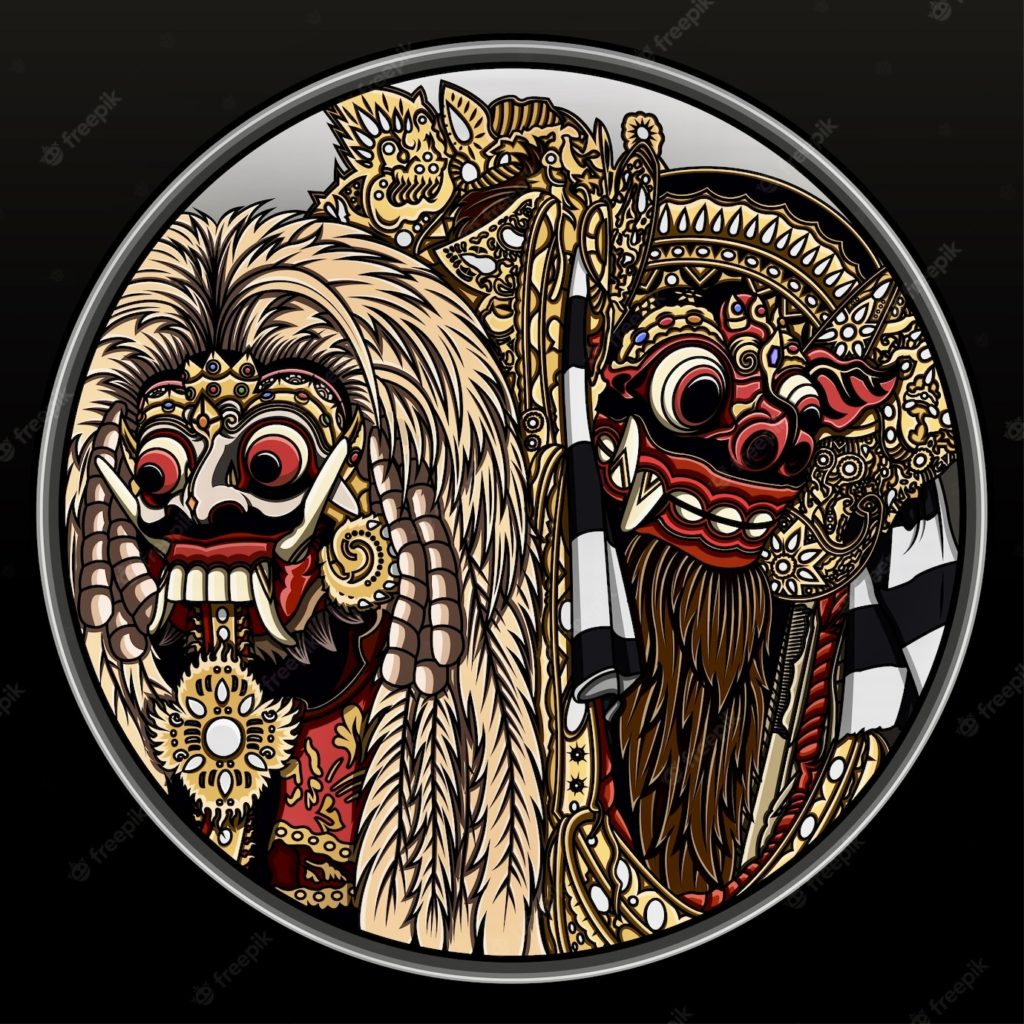Pictured: The Hero God Barong and his evil counterpart, the Demon Rangda. The Bali Gods and Demons are confusing to outsiders. Bali, an island the size of the USA state of Delaware, has more Gods per square mile than anywhere else on earth.
February, 2023 by Made Victor (the Bali name of writer Zephyr Carlyle) In Bali, a problem arises from all the Gods and Demons. The problem is not that there are too many, but that several look alike. A bunch of these Gods and Monsters all blur together; It is hard to tell them apart. You might think of some grinning ogre staring at you from an archway: “Is this a God or a Goblin? Is he one of the cheery, helpful Gods that I thank, or a menacing one that I appease; or do I need to turn around and run away? Right: In this picture, it is easy to see the differences between the Hero God Barong and the Demon Rangda. In other versions, these two beings look much more alike.
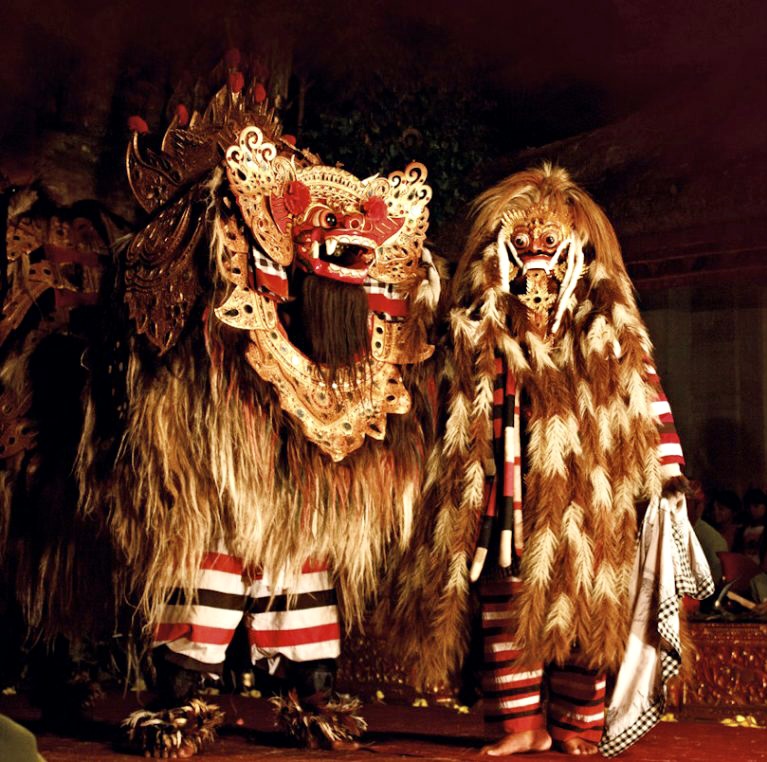
Plus, in Bali, supernatural beings are everywhere, which compounds the problem. That is, Gods and Demons are painted, carved, sculpted, drawn, and muraled, [is that a word?] everywhere in Bali — on street corners, home entranceways, shop overhangings, gardens, Temples, hotels — everywhere. And these same Gods and Demons walk the streets. You could run into a mainstay hero, a Barong, while strolling down the sidewalk. I did have such a sidewalk meeting with a Barong, as set out below. In another example: there is a special holiday, Nyepi, where all Bali residents hide indoors during this one day. The people stay in their homes to avoid a chance encounter with the Demon named Macaling. For one day a year, Macaling is allowed to roam the streets looking to snatch up sacrificial victims. I have read stories of people who were accidentally outside on Nyepi when Macaling passed by. Out of fear, they jumped into thick brush or a drainage ditch. The terrified residents could smell Macaling’s fetid order or hear his lumbered steps as he walked by.
So, Who are We Talkin’ About and What’s in it for Me?
This article tells readers both jaw-dropping stories of four Bali Gods and Demons, and explains how to tell them apart. When in Bali, you will know which supernatural beings to savor, and which to appease, or avoid. Do not forget to take the surprise quiz at the end of this article! The four beings are…
… the Gods Barong and Bhoma, plus the Demons Rangda and Macaling
These Bali Gods and Demons are from way, way back when; and not found in Indian Hinduism
As mentioned, these Gods and Demons are everywhere in Bali. Naturally, they are found in the Temples and not just in out in public. There are Temples dedicated not only to Gods, but dedicated to Demons, such as Macaling. These Dalem Temples exist to appease the Demon, or other evil spirits, and keep their evil at bay. Every day, in the streets and in Dalem Temples, Balinese make offerings, called “segehan”, to Demons in order to calm down their angers.
Bali is called the Land of 10,000 Temples and that is a wild minimization. Sure, there are thousands of Temples, starting with the nine main directional Temples. Then, we lump in the thousands of village Temples (every village must have at least three public temples) and do not forget the sea, occupational, ancestral, and water-spring Temples. Plus, every Hindu home must have a temple, whether tiny or cathedral-like. You do the math: there are four million people in Bali and 85% are Hindu. But how many people are in the average Bali home? We need that number to figure out how many family Temples exist. Does not matter what number you pick; simply add together all the home Temples using whatever formula you select, add them to all these other types ofTemples out there. The number will inexorably add up to over a million places to worship in Bali. The Gods and other supernatural beings dwell in, and are worshipped in, ALL of them.
Bali Religion in a Nutshell
The main religion in Bali is Hinduism, but it is quite different from the Indian Hindu beliefs. Indonesia is a cross-roads country and culture that creates a delightful mix of traditions. In Bali, Hinduism is also combined with some Buddhist beliefs; but mainly Hinduism is blended into an earlier, more traditional Indonesian animism. The pantheistic animism is the belief is that God is found in all things in nature. That is why in Balinese culture, people are very careful and respectful of the natural world, because everything has a deity that dwells within. God consciousness is embedded in every rooster, rock, river, and raincloud. The enormity of this idea sounds like Bali existence is severe and the people must be reverential to everything. The Balinese are certainly reverential, but not all somber and busy with endless head-bowing rituals. The Balinese religion is very festive with many Ceremonies, joyous pilgrimages, dances, purification rites, celebrations, village festivals, and the like. The Balinese also maintain a surprisingly upbeat, party atmosphere for normally serious occasions, like corpse cremations to honor the dead.
Take the Three Main Hindu Gods and then Add Some
Bali is called the “Island of Gods”, and they have Gods for every reason and season. Bali Hinduism fuses Hindu religion and philosophy onto the cultural backbone of their traditional beliefs. As mentioned, Bali Hinduism also incorporates some Buddhist traditions. However, the essential core of Bali Hinduism is reverence for the same Gods (or Dewas) as Indian Hinduism. Note: Dewa is the Bali word for God. Thus, the three major Bali Dewas are the mainstream Hindu Gods: Brahma, Shiva and Vishnu. Dewa Brahma is the God of all Knowledge, often painted in red in temples in Bali. Dewa Wisnu (Vishnu) is the merciful Protector of Life. He opens the cycle of life with his wife the Goddess of Fertility. At the other end stands Dewa Shiva, God of Death and Destruction, working together with his wife, Parvati, also known as Kali. Yet, the Hindu Gods are just the start of the Bali religion. The Hindu religion has been grafted on pre-Hindu animist beliefs. In that spirit, the three Hindu gods are seen as manifestation of Acintya, the highest God that predated Hinduism in Bali. Acintya is the apex Hyang which are a class of Gods worshipped in both Java and Bali since time immemorial. The Hindu Gods, upon arrival, were rolled right up into this traditional worship of the primordial Acintya and the other Hyangs.
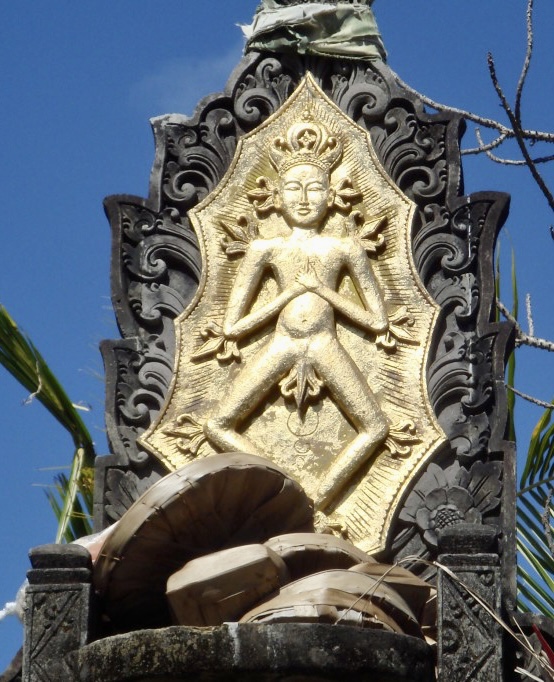
The Hindu Gods Cascade Into Many Forms and Flow Into Traditional Bali Culture
Emerging from Acintya and his triumphant manifestation of the Hindu Gods comes a gusher of other animist-Hindu Gods and Monsters. including Barong and Rangda. Hindu truths have been grafted onto the meaning of Barong and Rangda — good and evil, light and darkness. Barong is the embodiment of Lord Shiva. Rangda as the embodiment of Goddess Durga who is a manifestation of Shiva’s wife Kali. The Barong – Rangda story consists of their perpetual battle but neither Rangda nor Barong ever fully wins. This is a part of Shiva wisdom – two opposites are required to bring balance to the world. The enlightenment of oneself is required before erasing darkness in others. In that light, the Balinese believe that we are required to go through happiness and sadness. Light will eventually come even in the darkest time. In fact, we need darkness to see the light. Sadness is needed for happiness to be appreciated. In the end, death is absolute. This duality of life and death is like two sides of a coin, inseparable. Yet, life continues through reincarnation, creating the perfect balance. This is the Hindu wisdom underlying the battle between the Barong and Rangda. [Largely taken from: https://www.nowbali.co.id/the-philosophy-of-the-barong-dance/.]
Child-Eating Rangda is the Demon Queen of the Leyak Witches
Rangda is the Demon Queen, leading an army of Leyaks, practitioners of black magic. Leyaks were once good people but have turned evil. Leyaks are now blood thirsty and burst forth from their mortal bodies at night. They seek to drink their victim’s blood, especially the blood of children. Rangda also craves the blood of children, but brings disease, illness and death to all. Rangda has a long tongue of venomous spikes, vicious nasty fangs, and big ears. She has long hair that can be either light or dark colored.

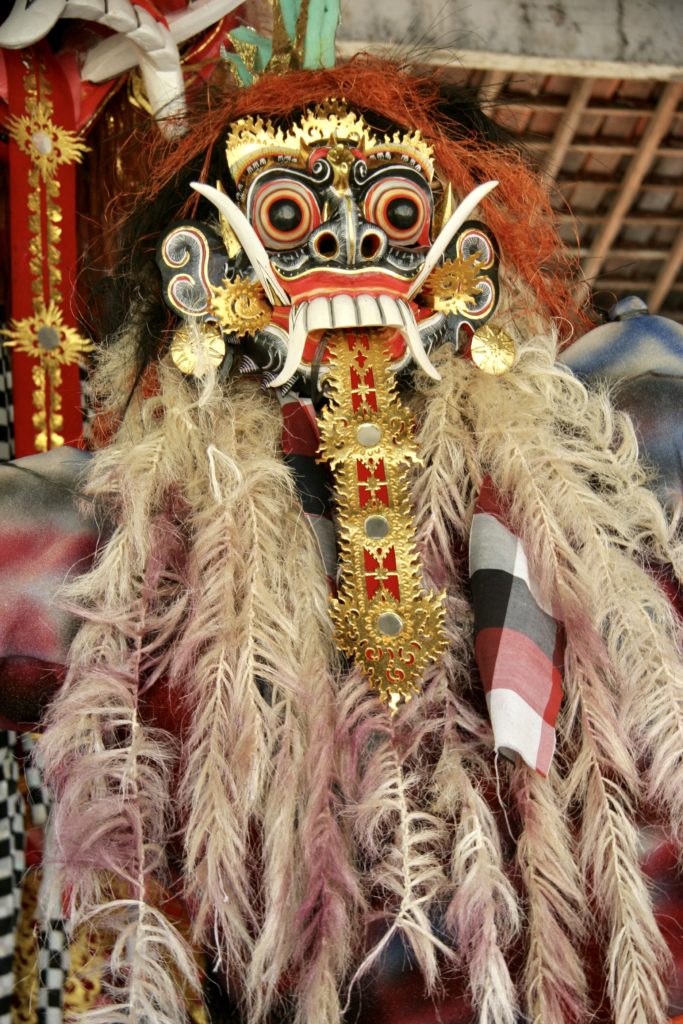
Rangda has the fitting role as the protector of cemeteries, and she is often found at graveyards.
Rangda has traction. She is part of the long tradition of inspired Bali culture. Here are some photos from the 1930’s but of course, she goes back much, much further than that:
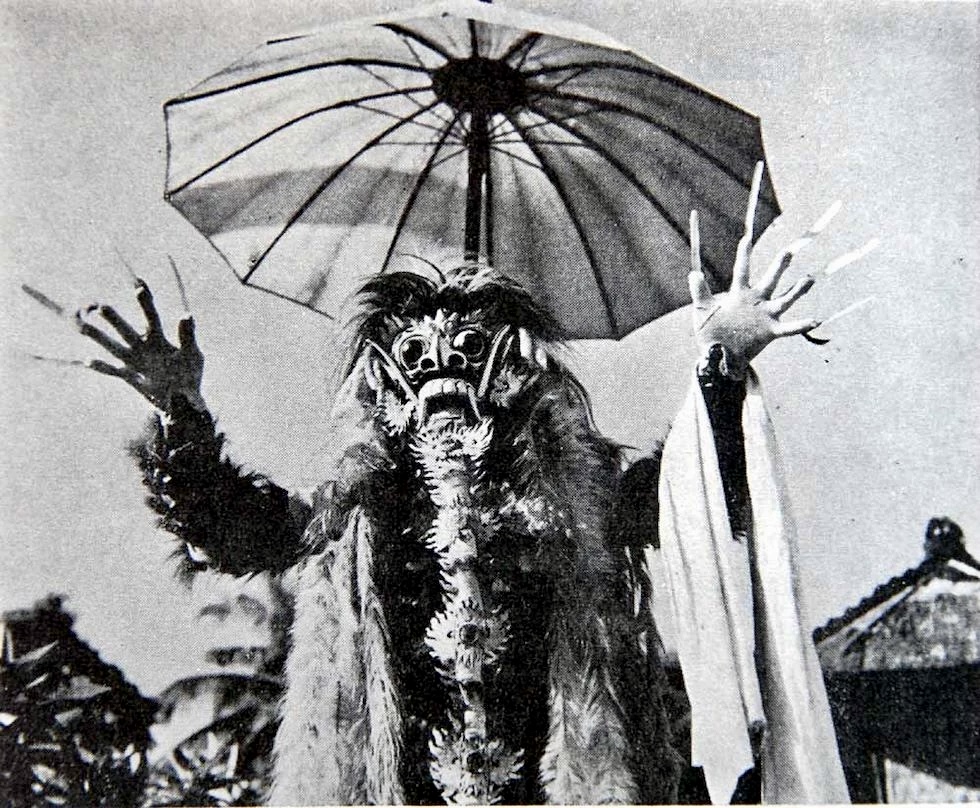
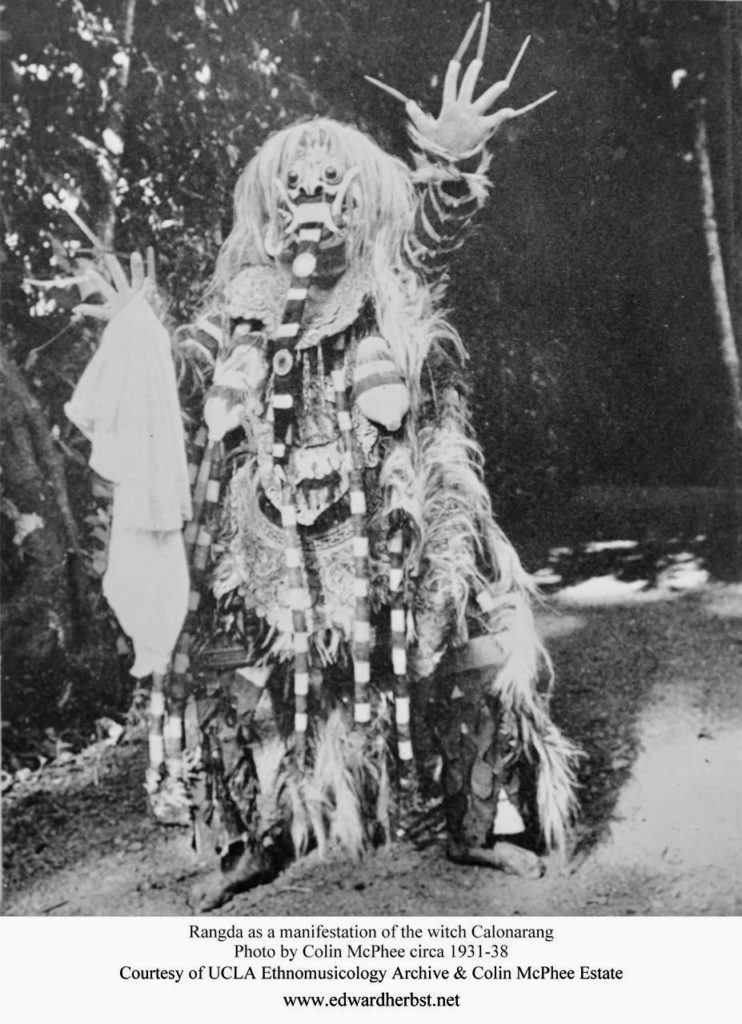
Barong is the “King of the Spirits” and “Leader of the Hosts of the Good“
The Barong is the ultimate Bali Hero and has the two intriguing titles listed above in the heading. He is an animal-like God, often in the form of a boar, dragon or panther (sometimes referred to as a lion.), or even an elephant! He can also blend the features of several types of animals. The Barong purpose in life is to engage in an eternal battle against Rangda. The Barong dance, together with the sanghyang dance, are considered native Balinese dances, predating the introduction of Hinduism to Indonesia. The word Barong refers to a good spirit, that took the form of an animal as the guardian of forest. Its origins could be from animist worship, before Hinduism appeared, when villagers still believed in the supernatural protective power of animals. Taken from Wikipedia, Barong. As to the Barong, he is out in full force, especially during the big Galungan Ceremony. Every neighborhood will have their own Barong out on the prowl, looking for Rangda. Here is Barong in action, in the good old days:
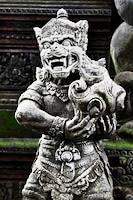
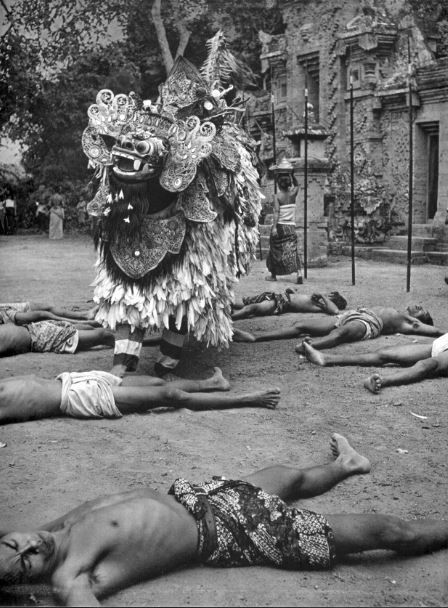
Here is the Barong in more modern times:
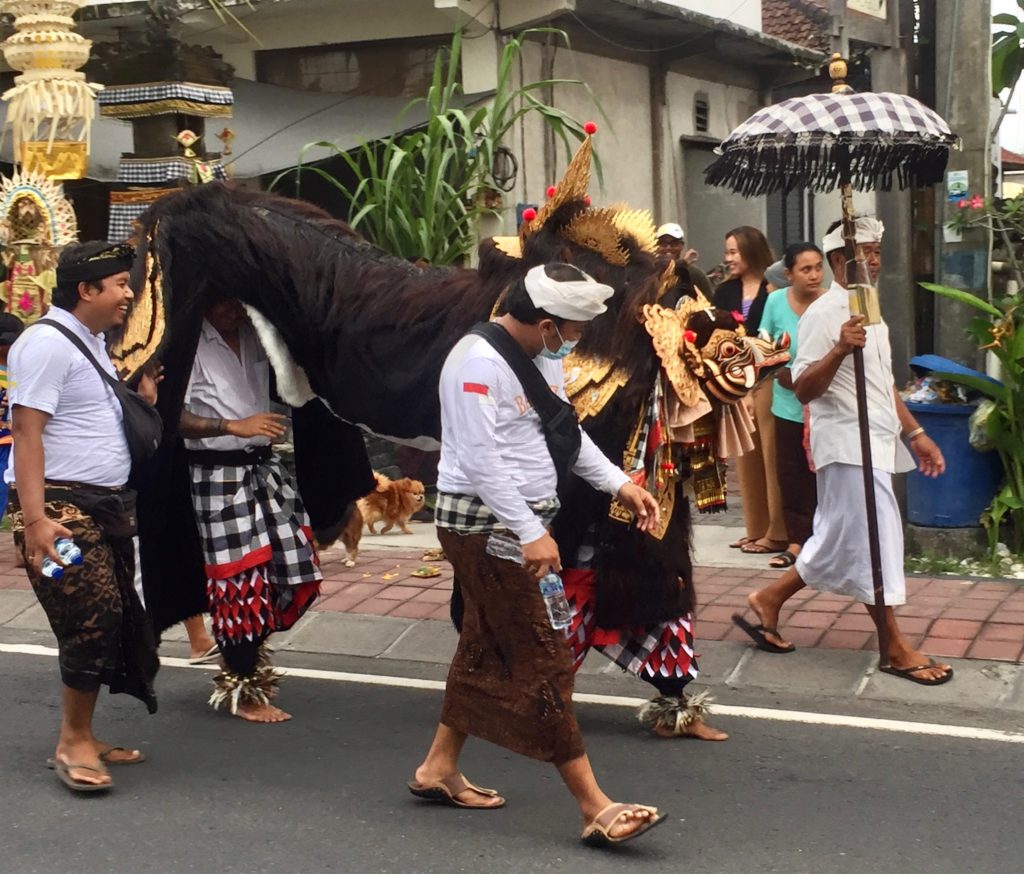
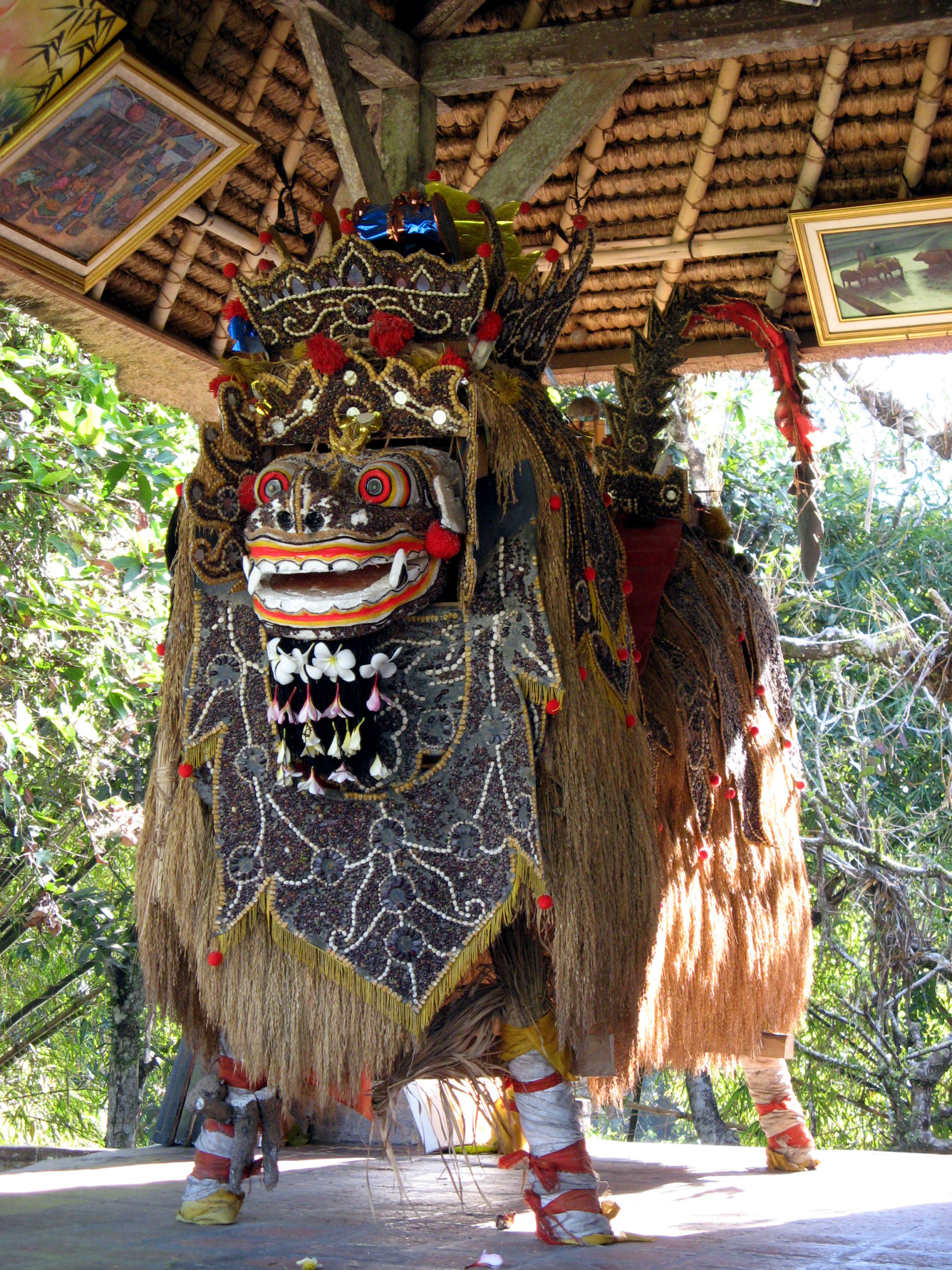
A Funny Thing Happened on the Way to the Grocery Store: I Met the Barong!
I live in Bali and know that the Gods are everywhere here. The other day, I was walking down the street in my home town of Sanur. Coming from the other direction was a little band of flute-and-gong players, a few groupies, and this Barong pictured below. They were all just parading down the sidewalk. The Barong was looking for Rangda, naturally. What the Barong did not know was that Rangda was safe in my nearby room.
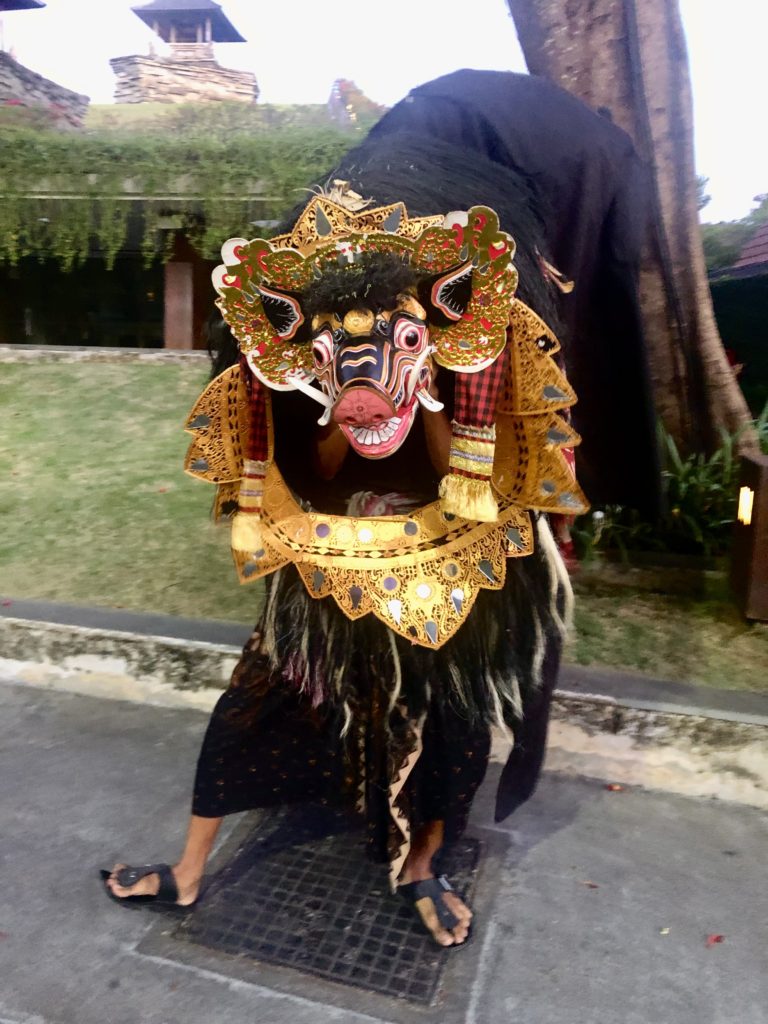
Above: The Barong who accosted me is a pig headed Hero. There are five different Barong in Bali, each defending his part of the island. A Barong can look like a wild boar, such as the one above, or a tiger, snake, dragon or lion.
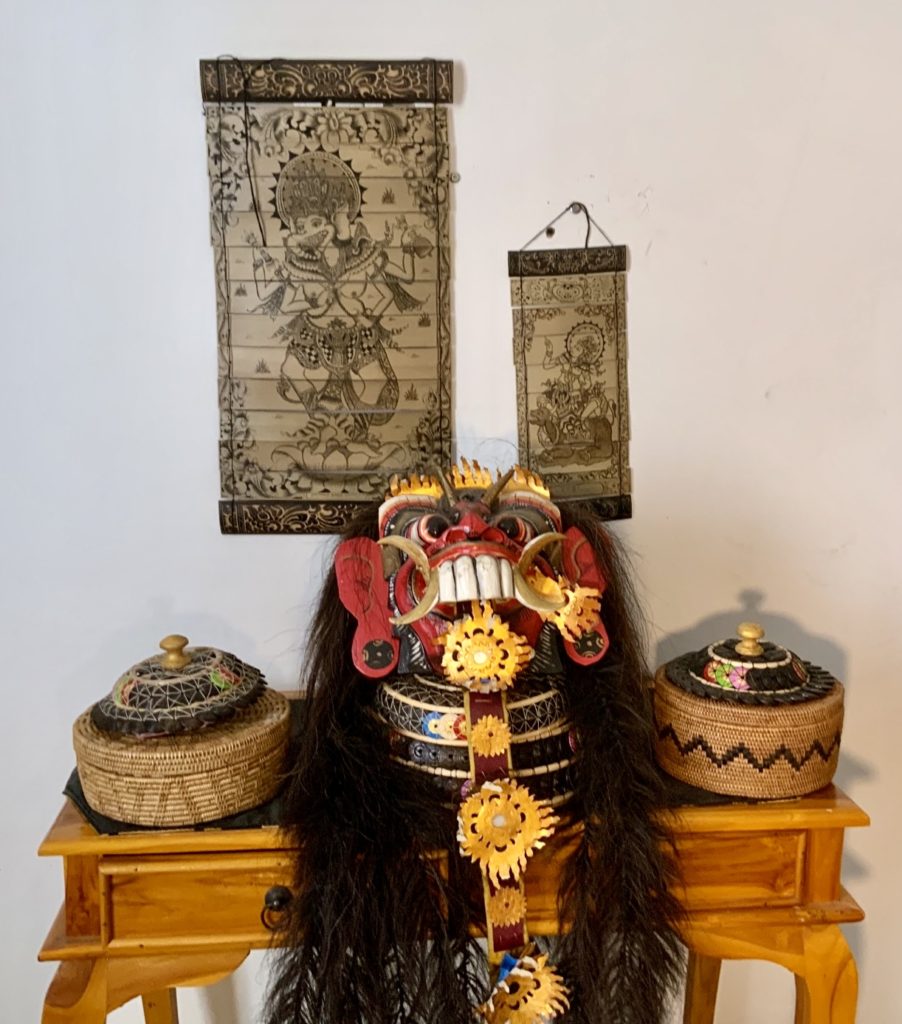
The Black Magic Demon: Jero Gede Macaling
Macaling, also known as Jero Gede Macaling was a powerful Warlock, practicing black magic and spreading diseases and misfortune. Macaling originally lived in Bali, in the small village Batuan. He was exiled to the nearby island of Nusa Penida because of his black magic. The angry Warlock decided to seek revenge and was consistently sending illnesses, epidemics and diseases to Balinese people. One day when Balinese people celebrated Nyepi (New Year) full of fun, joy and uproar, Macaling decided to fool the people and took the form of Barong. He went to Bali followed by an army of Demons. The Demons destroyed everything while their master was simply waiting for his victory. Since then, the Balinese New Year is a Day of Silence, nobody is making noise or having fun. In fact, everyone is forced to stay indoors out of fear of Macaling. On Nyepi only, Macaling is allowed free reign to travel around Bali looking for victims out to scoop up. He takes his captives to hell for the most horrible tortured treatment. Even the Bali International Airport is shut down on Nyepi to prevent people from coming and going on the roads.
When not terrorizing Bali, Macaling lives on his home island of Nusa Penida, also called Black Magic Island. On Nusa Penida, there is an important temple of Pura Dalem Penetaran Ped. The Temple houses a shrine for Macaling that is a source of power for practitioners of black magic. At the same it, the Temple is a place of pilgrimage for those seeking protection from sickness and evil. The locals make offerings for safe sea voyages from Nusa Penida. When in Nusa Penida, you may wish to join them to ensure a safe trip home, or other protection from evil.
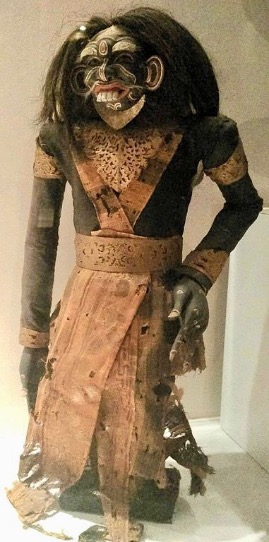
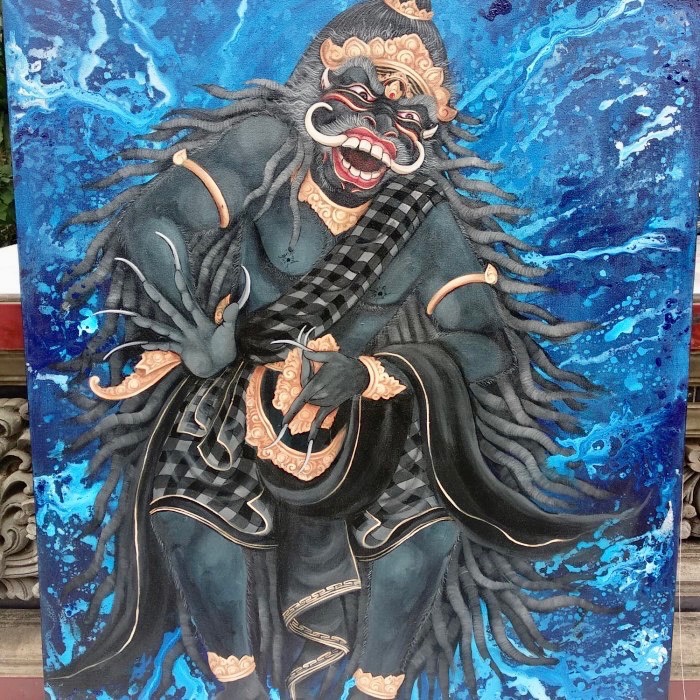
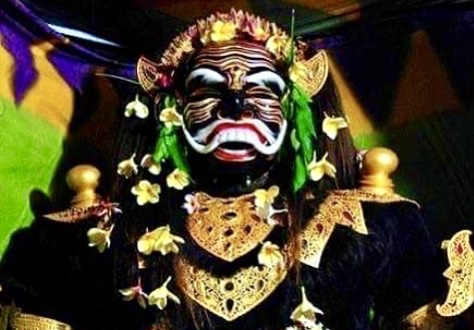
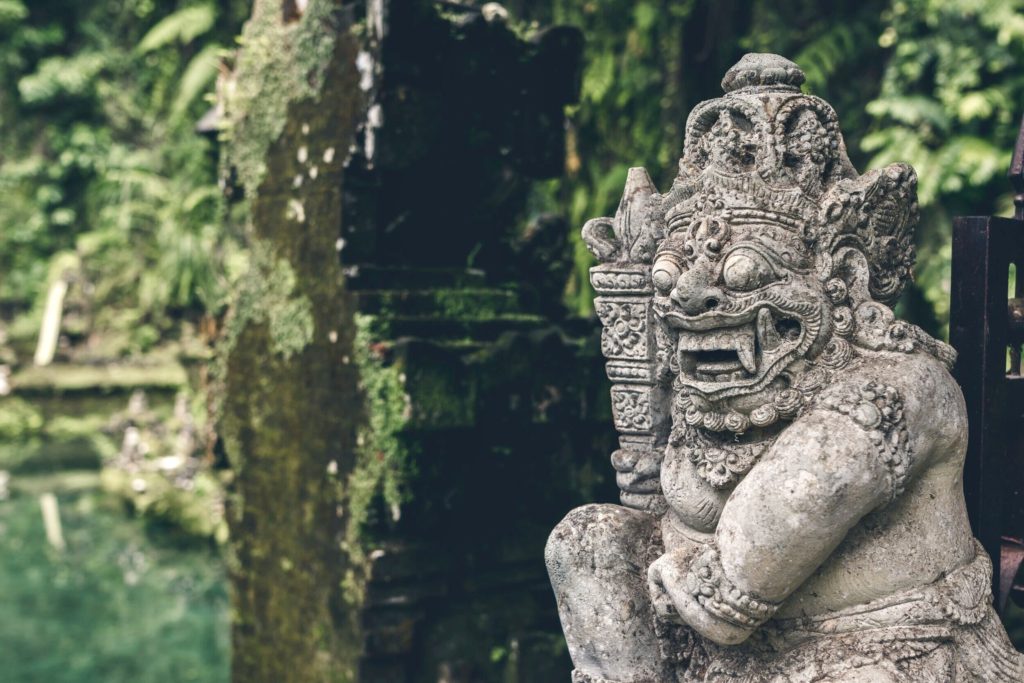
Bhoma the Temple Protector is both God and Architecture
Bhoma is a carved or formed grotesque figure which decorates certain parts in the Balinese temple complex. Bhoma is the son of Hindu Gods Dewa Wisnu (Vishnu) and Dewi Pertiwi. One day, when Wisnu was digging the earth in his avatar in the form of a wild boar, he had a fateful encounter with a beautiful Earth Goddess, Dewi Pertiwi. The subsequent union of Wisnu and Pertiwi produced a terrifying son named Bhoma. As to Bhoma, the pictures tell it all:
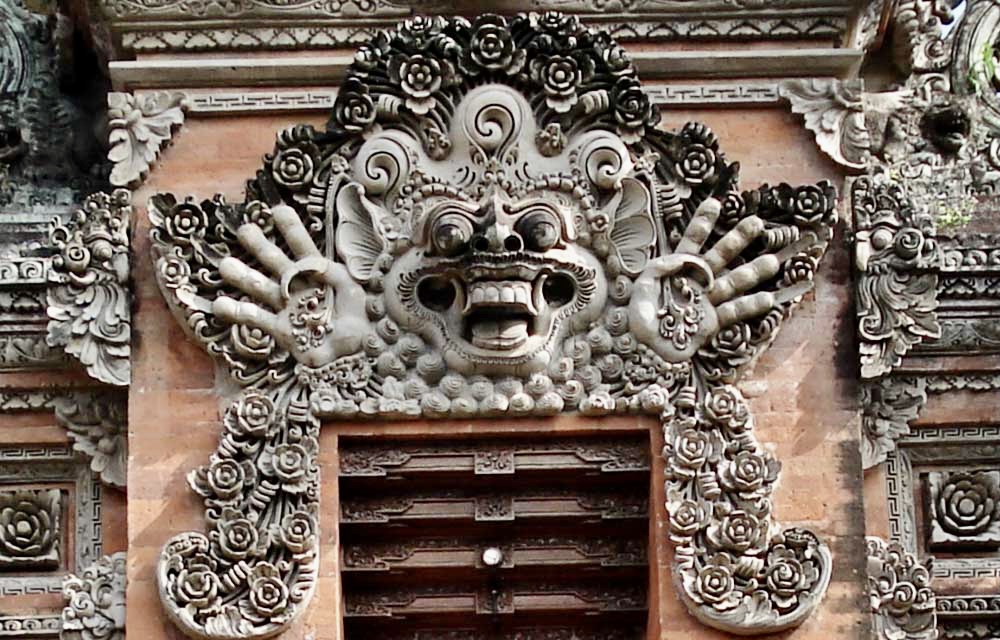
A very familiar face to all Bali tourists in the very disconcerting visage of Bhoma. This God guards the entrance of all the temples in Bali, or even the entrance door of private homes. Difficult to say if this large face with wide-opened mouth is smiling at Bali tourists or staring at them with a monstruous look. Bhoma’s attitude and demeanor depends on the visitors intentions when they enter a Bali Temple.
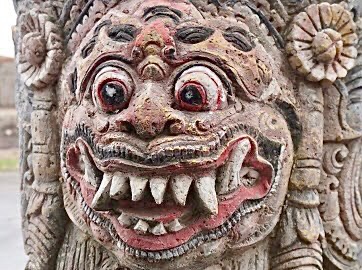
Do not mess with Bhoma as you enter the home or Temple: Be good of heart and filled with pure intentions as you want to stay on Bhoma’s good side

According to Wikipedia, Bhoma: ”In the Padmasana, the central shrine of a Balinese temple complex, the Bhoma head is carved at the bottom of Padmasana shrine to symbolize the forest which surrounds the base of a mountain.” Note: It may be a little difficult to discern the face of Bhoma at the bottom of this picture, at the very base of the Padmasana. In contrast, you can definitely pick out the apex God, the gold Aycinta at the top. Aycintya is the one Supreme Being to the Bali HIndus, see above introduction section.
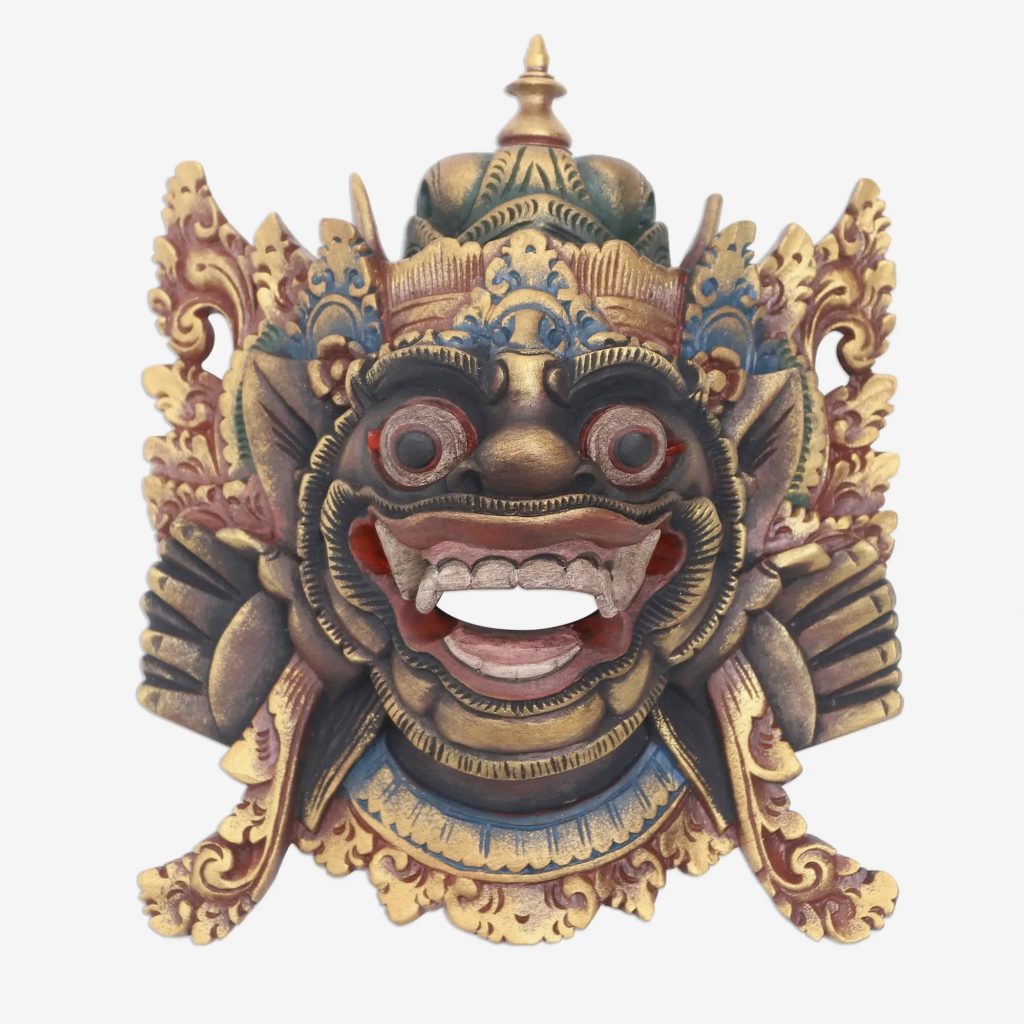
Above: A carved wooden mask of Bhoma meant as a wall hanging.
Can You Name that Bali Supernatural Being?–Take A Pop Quiz
Here is the challenge – Look at the pictures below. Each picture is one of our four Gods and Demons: Barong, Bhoma, Macaling or Rangda. Can you match the picture with the correct supernatural being? Answers are below the subscription sign up box.
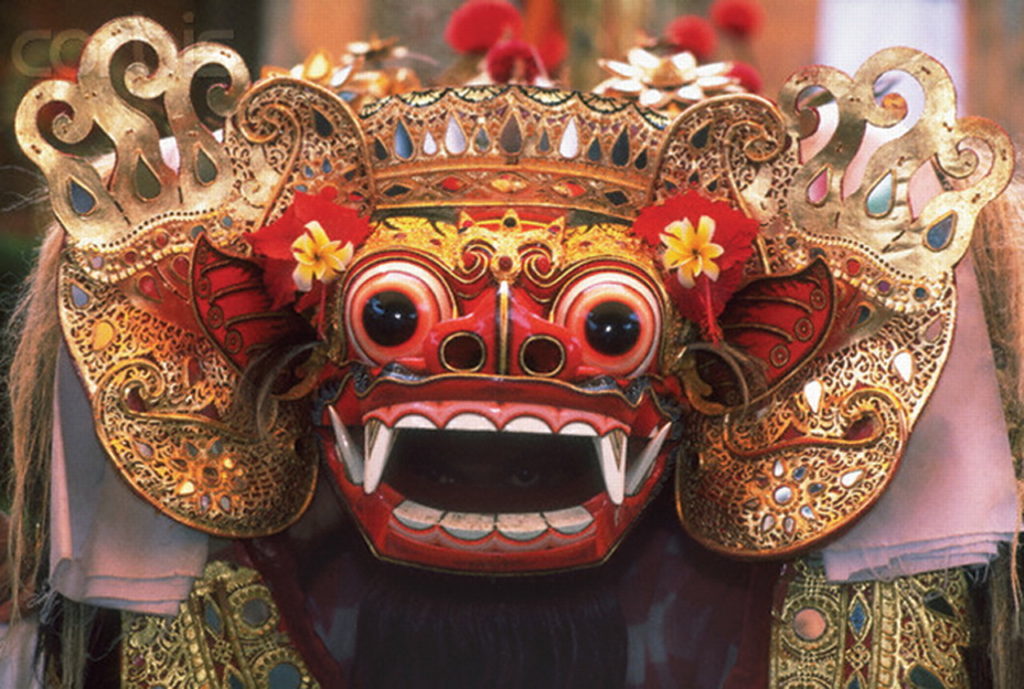
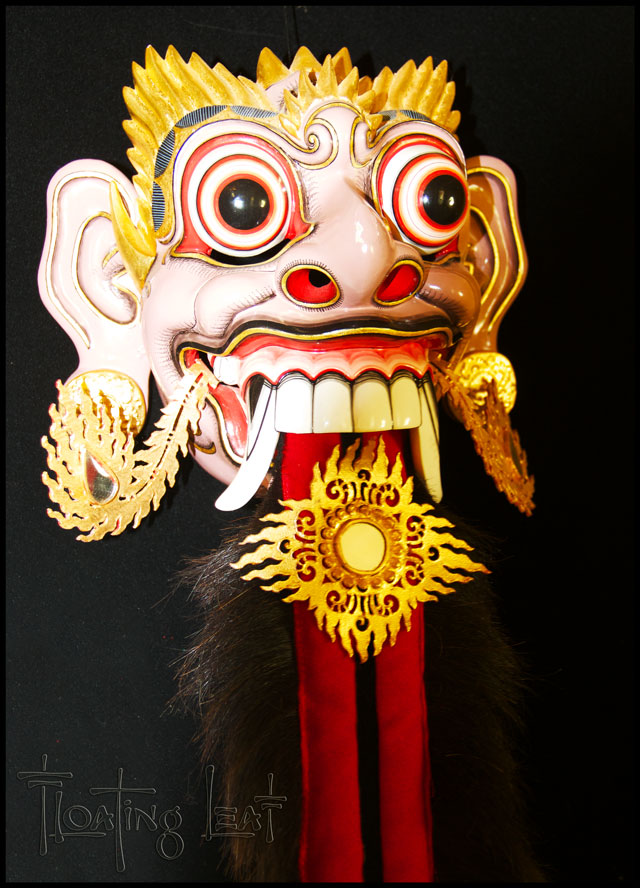
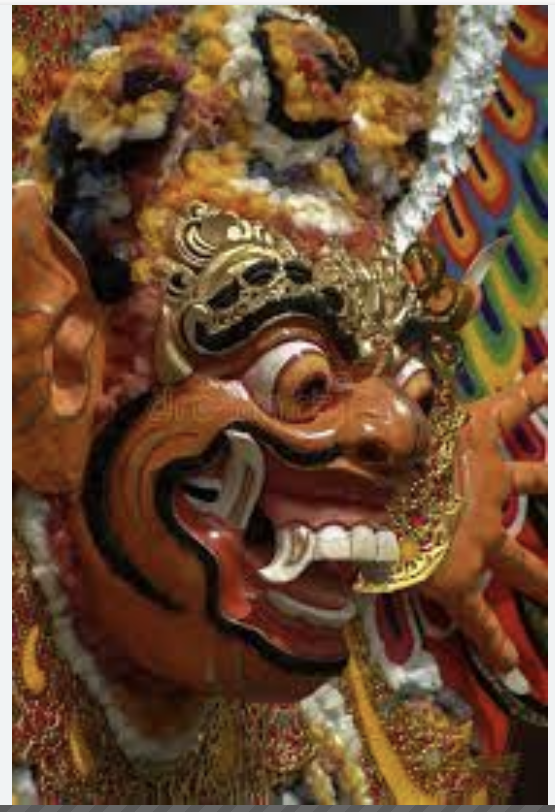
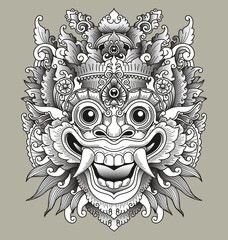
You are invited to join us as a member of Temples ‘n’ Tribes, a travelogue and literary journal. Subscription members get notice of the latest postings sent straight to their email inbox. The journal creator Made Victor posts about three new articles a month. And your email or other information will NEVER be sold or used in any way. Sign up for a free subscription below:
